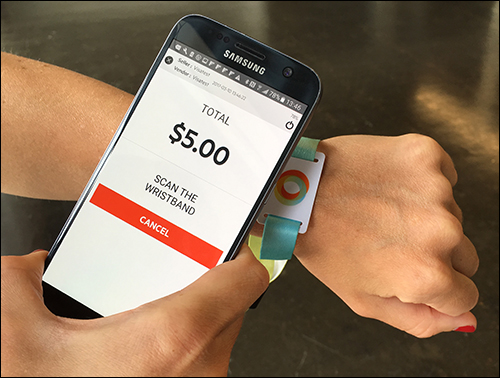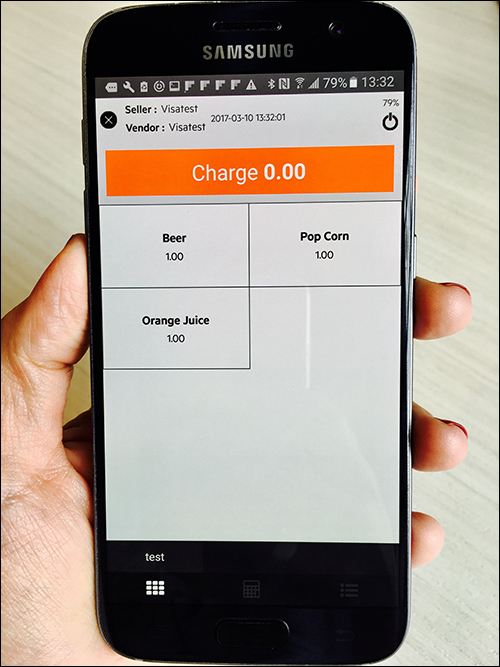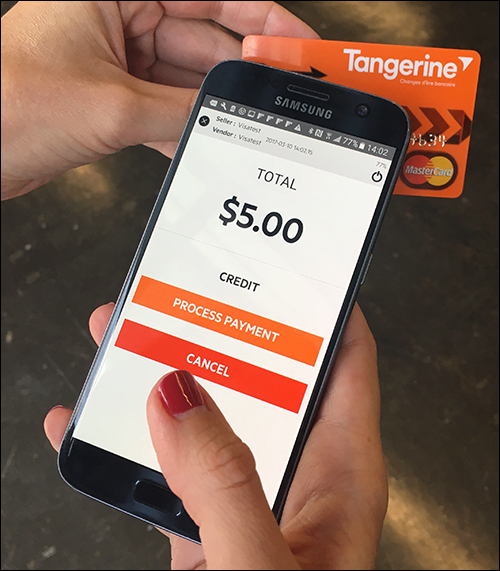Mar 21, 2017Attendees of the South By Southwest (SWSW) festival and conference, held this week in Austin, Texas, trialed a new solution from Montreal technology companies Connect&GO and Mobeewave. Those attending the Planet Quebec "Montreal for President 2020" party, held at the Quebec Sugar Shack, could make payments using a Near Field Communication (NFC) RFID-enabled wristband, credit card, mobile wallet or cash, all with the same Samsung NFC-enabled Android smartphone serving as a point-of-sale (POS) device.
Connect&GO says it has solved a cumbersome POS challenge for events by enabling vendors to accept payments from consumers in any way the customers want, via a mobile device. Connect&GO provides the NFC technology, app and software, while Mobeewave supplies the mobile contactless payment acceptance technology.

Everyone who received an invitation to the "Montreal for President 2020" party used an NFC-enabled wristband to gain access, enter a contest and share pictures on social networks taken of themselves and those they met at the party. They then had a choice of payment options for additional beverages: their wristband, or a traditional card, mobile wallet or cash, on a mobile phone.
Payments made via Connect&GO's and Mobeewave's all-in-one cashless solution are managed according to the various channels involved (such as banks and credit-card companies), by payment services company Global Payments, according to Anthony Palermo, Connect&GO's CEO.
The concept of a single POS device for any payment technology originated with Connect&GO's customers, Palermo says. These customers had approached the technology provider seeking a point-of-sale system that could be set up quickly (for events such as music festivals that are at a location temporarily) and that would allow all users to pay any way they wanted. Without such a system in place, he explains, individuals must use one POS device for credit and debit cards, or a different one for NFC reads (on wristbands, for instance).
Those who don't want to keep two POS devices on hand would need to have users load money onto a wristband account, or link a credit card account to a bracelet. That isn't always convenient, the company notes, especially in cases in which some attendees may not be wearing wristbands, or prefer to pay directly from a credit card or with cash.
The Samsung Android device using Connect&GO's app and Mobeewave finance services to ensure payment card industry (PCI) security compliance can serve as the only POS device, Palermo says. What's more, he adds, the system can be up and running within minutes, using a 3G or Wi-Fi network to access the server.

"We've found a way to standardize POS that's flexible enough to be used by the events industry," Palermo says. This includes deployment at food or music festivals, or at amusement parks or stadiums.
At the SXSW party, 2,000 wristbands were distributed to conference attendees. Each bracelet's built-in NFC chip had a unique ID number that was stored in Connect&GO's cloud-based software. Upon receiving a wristband, a visitor could then use his or her phone or other device to register, entering his or her name, e-mail address and social-media account in order to link them to the wristband ID. The guest could also opt to enter payment information to be linked to the bracelet.
As visitors arrived at the party, employees used a Famoco NFC reader to scan each wristband, confirm that it was valid and allow that individual to enter. Any attendee who wanted to purchase a drink could use the wristband (provided it was linked to that person's credit-card information) or a credit or debit card to pay for the additional beverage.
Either the wristband or card could simply be held against the back of the Samsung phone. The information would then be captured via NFC or contactless chip technology and Connect&GO's app.
In addition, employees with cameras mingled with attendees and took pictures of them. After taking a picture, a worker used a Famoco reader to read the wristbands of everyone photographed. That data was then sent via a Bluetooth connection to the camera, which used a Wi-Fi connection to transmit the information to Connect&GO's server.
Software hosted on the server then forwarded the picture to the e-mail address of each wristband wearer, and also posted it to the social-media pages of any individuals who provided their accounts for that purpose. The interaction also qualified participants to be entered into a contest to win two round-trip tickets and admittance to the C2 Montreal Conference, to be held in May.

The wristband technology was also used to manage crowd flow, Palermo says. Although it distributed 2,000 wristbands, the venue only accommodated 800 attendees at a time. Tracking such a large number of people traditionally requires a manual counting method with a clicker device, he notes—but with the NFC wristband, the system automatically monitored how many people entered and exited, and thus the real-time number of partiers at any given time. Once the maximum occupancy was reached, the system could alert personnel on their Famoco reading devices, so that they would not admit anyone new until others left.
Prior to the SXSW event, Connect&GO and Mobeewave conducted several trials of the cashless payment service at events throughout Montreal. Multiple companies have now begun discussing adoption of the technology for future events, Palermo reports.
Wristband use for payments has been proving to increase the quantity of consumer spending by 30 to 40 percent on average, Palermo says. This, he adds, makes the technology a popular choice for point-of-sale systems.

